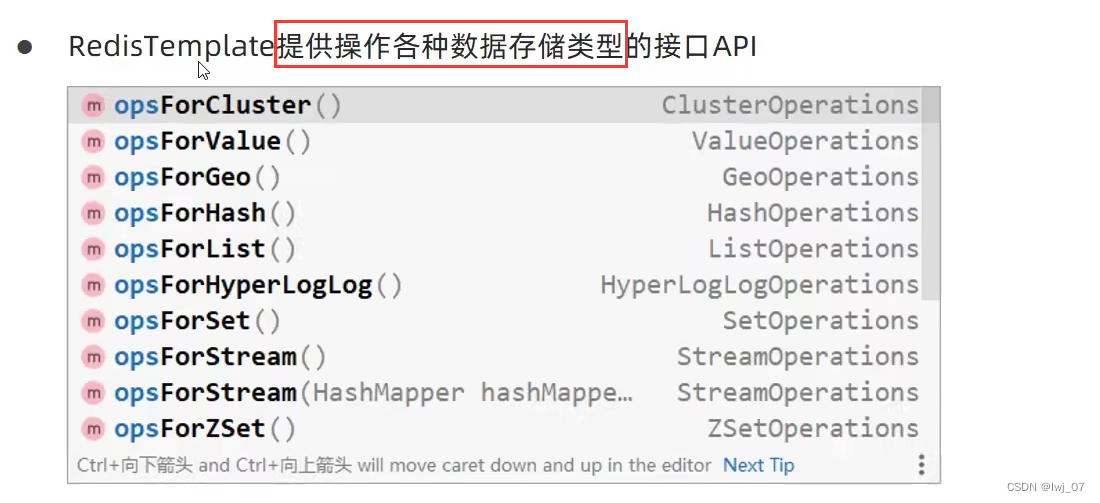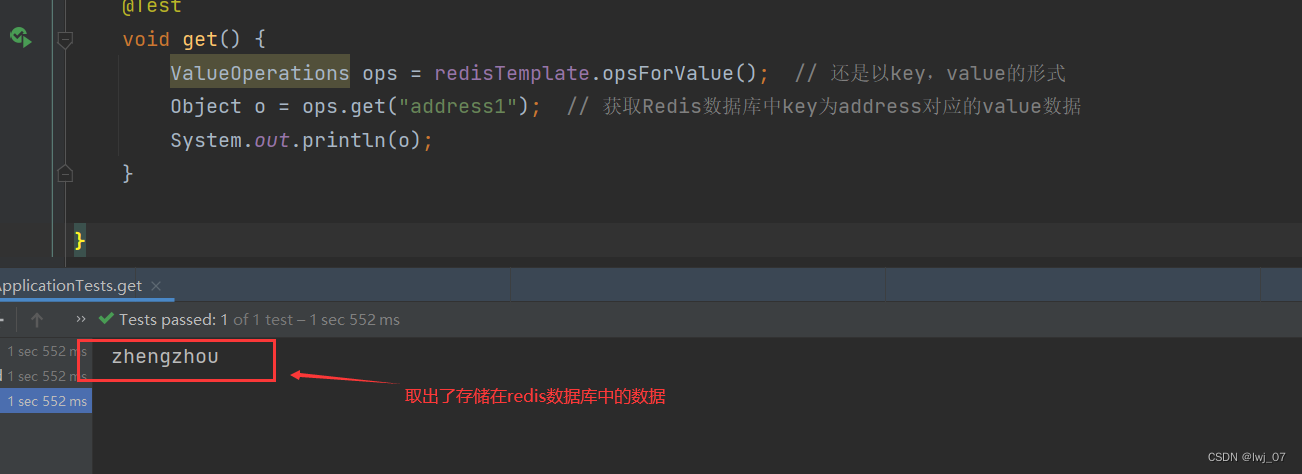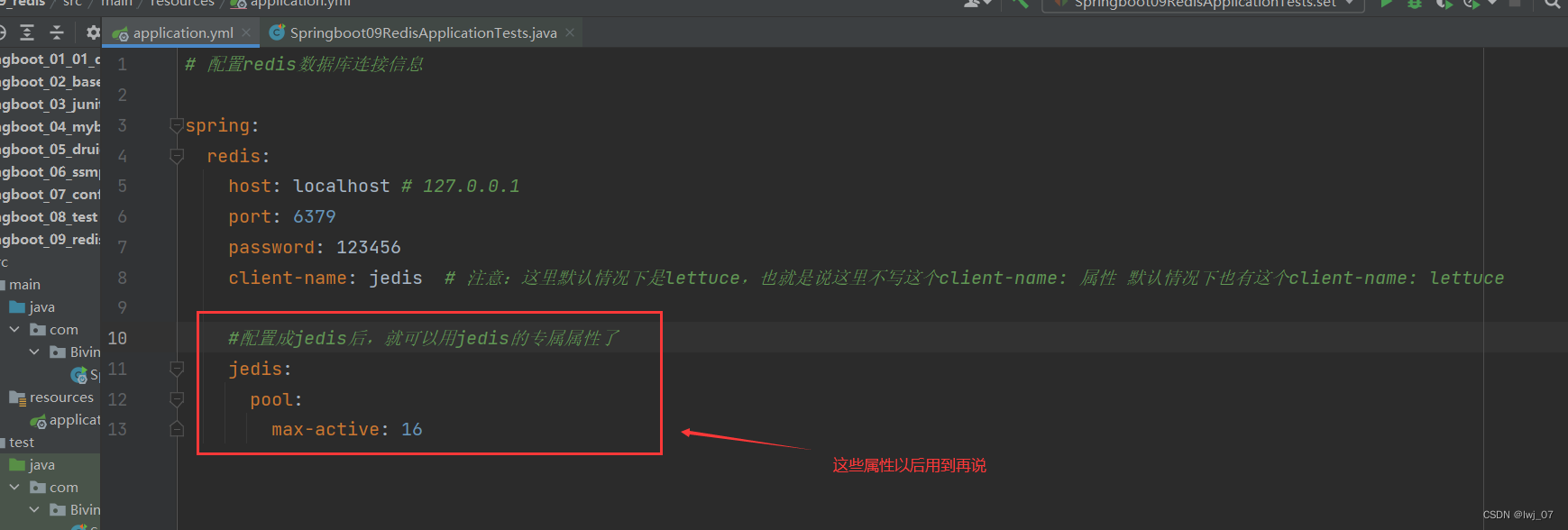- 1python多线程是假的_对比python的进程和线程:多线程是假的
- 2jsp小区车位管理系统_小区停车位管理系统研究意义
- 3android7 api中文版pdf,android 7 api 中文
- 4医院信息化系统大全_医院信息化应用名单
- 5Training language models to follow instructions with human feedback翻译
- 6在docker容器中使用显卡_docker 显卡
- 7MySQL与PostgreSQL抓取慢sql的方法_postgresql 提取慢sql
- 8梯度下降法有什么用?
- 9win11预览版更新,并尝试使用Copilot_vivetool v0.3.3
- 10机器学习、人工智能、深度学习三者的区别_人工智能机器学习深度学习三者
springboot整合redis_springboot redis
赞
踩
创建springboot整合redis工程:

一、springboot整合redis步骤
首先我们要知道什么是redis:

三步骤完成springboot对redis数据库的整合:
1、导入springboot整合redis坐标(上面勾选的那个就是)
2、在yml配置文件中配置redis端口号连接信息
3、自动装配RedisTemplate对象
补充:RedisTemplate对象提供了各种往redis数据库中存储数据的类型:

代码演示如下所示:
注意:下面所有的步骤,要保证Redis数据库是开启的状态,要不然肯定连接不上Redis数据库

第一步:

第二步:

第三步:
- package com.Bivin;
-
- import org.junit.jupiter.api.Test;
- import org.springframework.beans.factory.annotation.Autowired;
- import org.springframework.boot.test.context.SpringBootTest;
- import org.springframework.data.redis.core.RedisTemplate;
- import org.springframework.data.redis.core.ValueOperations;
-
- @SpringBootTest
- class Springboot09RedisApplicationTests {
-
- /**
- * 第三步:自动装配RedisTemplate对象
- */
- @Autowired
- private RedisTemplate redisTemplate;
-
-
- /**
- * 首先我们知道Redis是一款key,value存储结构的数据库
- *
- * 因此我们假定这个set()测试方法以key,value的形式往Redis数据库中存储数据
- *
- * key,value形式的存储命令:set
- * key,value形式的取数据命令:get
- *
- */
-
- @Test
- void set() {
- ValueOperations ops = redisTemplate.opsForValue(); // 首先redisTemplate.opsForValue的目的就是表明是以key,value形式储存到Redis数据库中数据的
- ops.set("address1","zhengzhou");// 到这里就表明Redis数据库中存储了key为address1,value为zhengzhou的数据了(取的时候通过key取数据)
- }
-
- /**
- * 取数据
- */
- @Test
- void get() {
- ValueOperations ops = redisTemplate.opsForValue(); // 表明取的是key,value型的数据
- Object o = ops.get("address1"); // 获取Redis数据库中key为address1对应的value数据
- System.out.println(o);
- }
-
- }


又因为我们知道Redis数据库支持多种格式的存储数据形式,因此还可以往Redis数据库中存储哈希类型的数据(哈希类型:就类似于一个key里面又放入一个key,value),因此Redis数据库哈希类型的储存/取数据演示如下所示:
- package com.Bivin;
-
- import org.junit.jupiter.api.Test;
- import org.springframework.beans.factory.annotation.Autowired;
- import org.springframework.boot.test.context.SpringBootTest;
- import org.springframework.data.redis.core.HashOperations;
- import org.springframework.data.redis.core.RedisTemplate;
- import org.springframework.data.redis.core.ValueOperations;
-
- @SpringBootTest
- class Springboot09RedisApplicationTests {
-
- /**
- * 第三步:自动装配RedisTemplate对象
- */
- @Autowired
- private RedisTemplate redisTemplate;
-
-
- /**
- * 向Redis数据库中储存哈希类型的数据(一个key里面放着一个key和value)
- *
- * 哈希类型的储存命令:put
- */
- @Test
- void hset() {
- HashOperations ops = redisTemplate.opsForHash();// 表明数据是以哈希类型的格式进行储存到Redis数据库的
- ops.put("info","a","aa");
- // 通过put命令,向Redis数据库中储存一个哈希类型的数据(一个为info的key里面放着一个key为a,value为aa的数据)
- }
-
- /**
- * 取数据
- *
- * 哈希类型的取值命令:get
- */
- @Test
- void hget() {
- HashOperations ops = redisTemplate.opsForHash(); // 表明取的是哈希类型的数据
- Object o = ops.get("info","a"); // 获取Redis数据库中哈希类型的数据(获取第一个key里面key为a的value数据)
- System.out.println(o);
- }
-
- }


二、springboot读写redis的客户端(必须看)
在上面的演示中我们知道,我们已经把Redis数据库整合到springboot了,上面我们也通过RedisTemplate对象往Redis数据库中储存了一些数据,也进行了在Redis数据库中取数据的操作,
我们思考:我们通过该对象往Redis数据库中储存的那些数据,到底真的储存到Redis数据库中了吗?
我们就拿上面往Redis数据库中储存的key为address1的数据,我们用cmd判断一下Redis数据库中到底储存了该数据没有: 答案就是没有

那么到底怎么才能把数据真正的储存到Redis数据库中呢:
因此我们需要把第三步中的自动装配的RedisTemplate对象换成StringRedisTemplate对象即可储存成功了。(因为Redis数据库都是字符串形式的数据,所以用StringRedisTemplate对象)


三、springboot操作Redis客户端实现技术切换(jedis)
第一步:导入坐标

第二步:配置客户端


总结:(面试必备)




